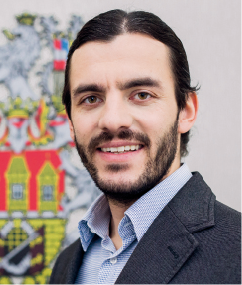
Dear readers,
let me start off this year’s 2020 Prague Transportation Yearbook with a few words about this past year, a non-traditional one for all. Transport behaviour in Prague transformed last year more than at any other time. The reasons why and where we travelled also changed. There was nowhere to go for entertainment, shopping, visits and, due to people working from home, often not even for work. We experienced and are experiencing fundamental restrictions on our lives in connection with the coronavirus pandemic, and this is in part reflected in a markedly lower demand for mobility. Choice of individual types of transport is also constantly changing. The development of pedestrian and bicycle traffic was critical. Pedestrian traffic was the only type of transport not to record a decline in the modal split (with the exception of tourist numbers) and bicycle transport even registered a strong increase.
This development led to a very interesting result. When individual automobile traffic at first dropped 35 % and then remained at least 20 % below regular levels, our streets became much safer and provided much easier passage for cars. This led to a feeling of safety for pedestrians and cyclists and this in and of itself facilitated the spread of these types of transport. From among the major projects for pedestrians and cyclists last year, I would like to highlight the opening of the Trojská lávka (Troja Footbridge) and the transformation of the intersection Karlovo náměstí x Resslova, where after decades, the inability to cross one of the biggest squares in Europe barrier-free was finally rectified.
I wish to emphasise one thing. We speak a lot about public transport, pedestrians and cyclists, but these efforts stick out for one reason only: in the past these areas were unfortunately overlooked. This certainly does not mean that this comes at the expense of other types of transport and we are certainly not letting up in road works. The efforts we devote to individual types of transport are based on where the circumstances so require. In major cities around the world, mass public transport has the greatest efficiency. The healthiest methods are walking and cycling. But at the same time it is necessary to build high-capacity roads for bypassing the city.
We began renovating Barrandovský most and I would include the load tests of Libeňský most among the year’s other extraordinary activities. Never before have tests been done where each arch is given a load of over 500 tonnes and at the same time a fully loaded tram passes over at a speed of 60 km/h. This extreme load convinced the broad professional public that renovating the bridge is the proper approach and this architectural gem connecting Prague 7 and 8 can be saved. The iconic arches will undergo sensitive reconstruction, with a completely new bridge over Rohanský ostrov to connect to it based on Janák’s original sketches.
Work is also underway on finishing up the plans for the last part of the City Ring Road. We provide the state with maximum support in preparation of the Prague Outer Ring Road, but we have also commenced project work on increasing the capacity of the Průmyslový polookruh and Jižní spojka. These latter two roads can be of fundamental assistance for transport through the city much sooner and be highly effective before the two ring roads are completed. As such they will play an essential role before the former have been completed and can fully stand in for them. Last year we already managed to finish increasing the capacity of the on- and off-ramps from the Barrandovský most to Modřanská, at the crossing of Cínovecká and Kbelská and the ramp from 5. května to Türkova.
Happy travels and above all safe travels around Prague in 2021.
Prague, 30 April 2021 |

Ing. Adam Scheinherr, MSc., Ph.D.
Deputy Mayor of the City of Prague for Transport |





